Shagadelic!
by Laura Barnett Sawchyn, IIDA TCW

CLICK TO SEE IMAGE

CLICK TO SEE IMAGE
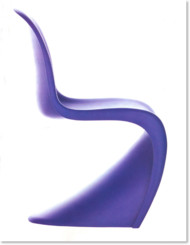
CLICK TO SEE IMAGE
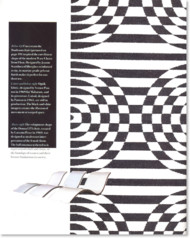
CLICK TO SEE IMAGE

CLICK TO SEE IMAGE

CLICK TO SEE IMAGE
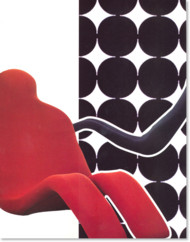
CLICK TO SEE IMAGE
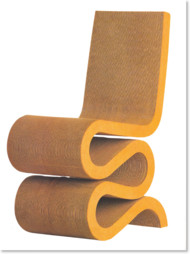
CLICK TO SEE IMAGE
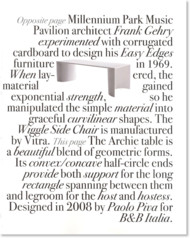
CLICK TO SEE IMAGE
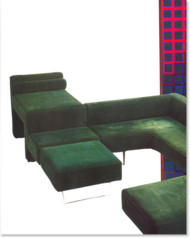
CLICK TO SEE IMAGE

CLICK TO SEE IMAGE

CLICK TO SEE IMAGE
1969 was a pivotal year in many ways--as much as things stayed the same, they were changing at the speed of light. As flower power swept the nation, Richard Nixon was sworn in for his first term as president. Neil Armstrong walked on the moon and Woodstock rocked the summer music scene. Elvis sang along with The Beatles and The Rolling Stones on the Top Ten music charts and James Bond battled Butch Cassidy and the Sundance Kid at the box office.
All of this turbulence revolutionized the way we thought, behaved, and lived. It couldn't help but inspire designers to develop new patterns, materials, and manufacturing techniques. Not only did clothing styles become more architectural and geometric, but shapes were shifting everywhere along with attitudes, introducing new line and color to interior design elements.
While some of these innovative furniture designs have gone the way of go-go boots; others have inspired the contemporary furnishings that are manufactured today. I've shown you both, so you can make the comparisons as you read through this article. Some of the best designs of the period survive in their original state and are still in production. Those particular pieces embody the age, and have become exactly what the radicals of the time were rebelling against-classic.
So as we watch the new James Bond on Blue Ray and welcome President Obama to the White House, let's light the candles on the birthday cakes of these forty-year-old designs. We can celebrate their creation, what they have inspired, and how much we have grown in the process. AND The Stones are still around to party along with us!
Fantastic Plastic....
When, in 1967 Mr. McGuire told The Graduate, Benjamin Braddock, to remember one word, "Plastics," he might have had these chairs in mind. The ability to contour the shapes to follow the human form provides support where needed and surprising comfort.
The plastic single form injection-molded chair by Verner Panton was much imitated by 1969, and appears in the Museum of Modern Art in New York. Produced by the Vitra Company. (Photo #1)
The Italian design team of Dondoli and Pocci designed these modern versions for Bonoldo. The "Vanilla" chair (Photo #2) is a combination of materials, molded plastic on a chrome base. Contradicting their name, they are available in other color choices in addition to white. You'll rock on these stylish not-for-granny "Flip" chairs (Photo #3)-multi-colored and fun! Available at Pauline Grace.
The "Archie" table is a beautiful blend of geometric forms. Its' convex/concave half-circle ends provide both support for the long rectangle spanning between them and leg room for the host and hostess. Designed in 2008 by Paolo Piva for B&B Italia. (Photo #4)
"Sacco", the original bean bag chair, was designed in 1969 by Pietro Gatti, Cesare Paolini, and Franco Teodoro. Its' distinctive shape is familiar to children across the universe and has been widely copied. Filled with polystyrene pellets, the original conforms to the body with an integral headrest and is adult-sized. Manufactured by Zanotta, in a variety of fabrics and leathers, this 20th Century icon is in the collections at the V&A in London and MOMA in New York City. (Photo #5)
Transparent polystyrene and Lucite became more refined by 1969. Gone were the clumsy bolts that held pieces together, replaced by space age adhesives that bonded the seams with remarkable strength. Used for tables, chairs, and accessories, they blended with absolutely everything as if they weren't even there. The Clear Choice for 2009 is the mirage chair available from Pauline Grace. The polycarbonate used to make the Mirage chairs is totally recyclable. The red bistro table shown with the chairs is metal and is offered in many other painted finishes. (Photo #6)
Still crazy after all these years....
As with all new shapes and materials, some are embraced and others left behind. While these designs are found in highly regarded museums, not all are still in production, ready and waiting for you to buy one for your very own.
The architect of Millennium Park's Music Pavillion, Frank Gehry, experimented with corrugated cardboard to design his Easy Edges furniture in 1969. After discovering that when layered, the material gained exponential strength, he manipulated the simple material into graceful curvilinear shapes. The Wiggle Side Chair is manufactured by Vitra. (Photo #7)
Charles and Ray Eames started designing furniture in the 40's, but this management desk chair came into production in 1969 and hasn't changed since. The individual soft pads conform to each body differently and allow for comfort throughout the long workday. Manufactured by Herman Miller. (Photo #8)
Olivier Mourgue's playful and practical Bouloum chair was named for one of his childhood friends. Its' anthropomorphic design consists of a tubular steel frame padded with urethane foam, upholstered in brightly colored polyester. Undoubtedly, nothing like this would have been considered furniture prior to the 60's! Visit it at the MOMA in New York or populate your media room by ordering several from Arconas. (Photo #9)
I'm certain Bouloum inspired the curvilinear shape of the new Wave Chaise from Float. (Photo #10) Designed by Jeanne Scandura of fiberglass reinforced resin, its' marine-grade gel coat finish makes it perfect for outdoor use, but it could add quite a splash to your interior furnishings, as well.
The voluptuous shape of the "Donna UP5" chair was designed as an abstract interpretation of the female form. The ball ottoman that is tethered to it was to represent a ball and chain, or the bondage of women and their former limitations in society. Gaetano Pesce designed it in 1969 for a very different world. We've come a long way, baby. Manufactured by B&B Italia. (Photo #11)
Seating section....
Modular and multi-use furniture was a fresh idea in the 60's and even the simplest L-shaped sofa was considered extreme.
Vladmir Kagan's 1969 "Omnibus" series has block forms, chrome legs, and multi-levels, pushing the design to new heights, and is still in production. (Photo #12)
These new designs still have block structure and chrome legs, yet sit more comfortably that the originals. The manufacturers have discovered how to use softer, down fill for the cushions and still maintain the crisp, square edges. There are many sizes and shapes available in each series, giving you the ability to custom build a unit from standard pieces to fit your needs and your room size.
(Photo #13) "Dolce Seuardo" series from Design Studio Furniture (Photo #14) "77" sofa series from Neidermaier.
The "Pierrot" sofa doubles as a sleeper, but no mattress to pull out or extra cushions here. The back reclines to a flat position and fits to the seat like a puzzle part-clean and easy for a nap or weekend guest. By Bonaldo and available at Pauline-Grace. (Photo #15)
Pattern OP-tions...
The phrase "Op Art" was coined by Time Magazine in 1964, to describe some types of geometric patterns that created an optical illusion, whether black and white or in color.
Victor Vasarely is the master of warped space, precision edges, and vivid color combinations. His paintings were the first of their kind and are in museums all over the world. His stunning images are immediately recognizable and have had great influence on contemporary art and motifs. Check out the dimension of his "Gestalt" painting series of the late 60's and early 70's. (Photo #16)
"Optik" fabric (Photo #17) designed by Verner Panton in 1969 for Maharam certainly falls into this category. Its precursor, "Unisol" (Photo #18) designed by Panton in 1965 is also still in production. The black and white imagery creates the illusion of movement or warped space, a somewhat psychedelic experience!
Also still in production from Maharam is Alexander Girard's "Toostripe" (Photo #19). This vibrant coloration is very representative of the period-- when color combinations were being pushed to the limit.
Brand new pattern renditions are designed by Larry Laslo for Robert Allen Fabrics. Both "Cuff Links" (Photo #20), shown in midnight, and "Pure Element" (Photo #21) in amethyst, convey the point of view of their earlier counterparts. Both are bold graphics and play on positive and negative space.
Click below to download PDF of entire article.
